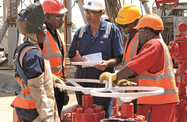With first production due to begin next year at Kenya’s newly developed oilfields in the north, plans are under way to put in place the necessary transport infrastructure to ship the country’s crude to the eastern coast.
Key to transportation
As of mid-October UK- and Ireland-listed oil and gas producer Tullow Oil was looking to contract trucking companies to transport the crude oil taken from the South Lokichar Basin in Kenya’s Turkana County.
In an advertisement in local media, Tullow Oil said it was seeking to lease 100 tankers with a minimum fluid capacity of 25,000 litres to move the early production to storage facilities in Mombasa operated by Kenya Petroleum Refineries.
Currently, the South Lokichar Basin in Turkana County has around 750m barrels of recoverable crude oil in reserves, though further exploratory drilling is scheduled in the adjacent North Lokichar Basin, with estimates that total reserves could rise to at least 1bn barrels of recoverable oil.
The oil blocks located in both basins are held by Tullow Oil and its partners, Canadian oil and gas company Africa Oil Corporation and Denmark’s Maersk Oil.
While the initial flow is expected next year, full production should come on-line by 2020, according to a statement issued by Tullow Oil in early October.
Connecting the dots
The tanker trucks are only a temporary solution, as Kenya is planning to eventually construct a 865-km pipeline linking the Lokichar Basins in Turkana County to a refinery at Lamu Port as part of the larger Lamu Port-Southern Sudan-Ethiopia Transport (LAPSSET) corridor, a $24.5bn project designed to provide road, rail and pipeline links to countries throughout the region.
A new 32-berth deepwater port in Lamu will serve as the anchor of LAPSSET, with an oil export terminal and refinery allowing for the shipping of both crude oil and processed products. Onshore construction work and dredging to deepen Lamu Port’s docking area for ships began in mid-October.
The government has also begun work on the pipeline component. Kenya’s National Land Commission issued a notice of intent in October to acquire just over 3760 ha of land as part of the LAPSSET corridor in the counties of Lamu, Garissa, Laikipia, Meru, Isiolo, Baringo, Turkana and Marsabit.
While the development of Lamu Port is continuing apace, the LAPSSET project has seen some potential partners opt out, with Uganda and Ethiopia both striking agreements to ship their oil exports via pipelines passing through Tanzania and Djibouti, respectively, potentially narrowing the scope of the LAPSSET corridor.
Rwanda – another country that has decided to step away from the project – recently announced it was looking to develop rail links through Tanzania to the Indian Ocean, rather than connecting with the Kenyan network and Port Lamu.
Though there have been some withdrawals, both the energy component of the development programme and the broader projects are still commercially viable and progressing, according to Silvester Kasuku, director-general and CEO of the LAPSSET Corridor Development Authority.
“As the pipeline connecting the Lokichar fields to Lamu Port will complement the Djibouti pipeline, Rwanda and Uganda’s pullout of Kenyan infrastructure projects still leaves the LAPSSET Corridor projects very feasible,” he told OBG.
Pipeline potential
Ultimately, Kenyan authorities hope that the LAPSSET project will benefit from exploration and production efforts elsewhere in the country.
The results of further exploration in northern Kenya, along with the potential for South Sudan to utilise Kenya as an export route, will support the pipeline project and other downstream facilities, Gabriel Negatu, regional director for East Africa at the African Development Bank (ADB), told local media in late September.
However, while initial flow from the Turkana fields is expected in early 2017, global energy prices will need to stabilise before Kenya’s oil exports can be viable in the long term.
The price of oil should be at least $50-$55 per barrel to make the exploitation of Kenya’s reserves profitable, according to data issued by the Ministry of Energy and Petroleum in early October.
In the medium term, with the ADB forecasting oil prices to stabilise at around $60 per barrel next year, Kenya should see its minimum price clear as production ramps up.
Oxford Business Group is now on Instagram. Follow us here for news and stunning imagery from the more than 30 markets we cover.

